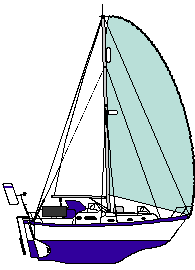

I used to have a print which showed a gaff-rigged ketch in ten little drawings from full sail through various stages of reef down to storm sails only. I imagine it was originally a kind of teaching-aid from the days of sail. When I heard Chay Blythe talk once about his famous round-the-world trip he confessed that he was no great sailor when he set out from England. The boat was fully equipped for him but he had never used some of the gear. As the escorting boats fell back and he found himself alone for the first time, he decided to try out the reefing and the storm sails. It was a lovely clear, sunny day in the English Channel. He went through each stage of reducing sail until he was down to nothing but a tiny storm-jib and try-sail. At that point an RAF reconnaissance aircraft flew over him, just to have a look, probably carrying photographers. "Gee-whizz," he imagined them saying, "He's taking no chances, is he?"
The secret to handling rough weather at sea is for it not to be an adventure into the unknown. Of course there are always conditions worse than you've ever seen before out there somewhere, but you must have a plan, tactics and the gear and know-how on board to put it into practice. When the wind starts to build, you just go from A to B to C to D, following a procedure which makes it ok at each point.
 |
| Rusalka Mist under full mainsail and mps. |
So what are our plans? First, if there is any risk of a blow, we do not have the mps (or spinnaker or cruising-shute) up. If it is up, we always have the full main-sail up too. The idea is that you put the boat onto a run and the main blankets the wind from the mps, then you can use the sock to tame the beast and get it down quickly. The mps is the biggest sail we have on board. The next biggest is a 130% genoa. This flies from the roller-reefing and can easily be rolled away if the wind gets over about Force 3.
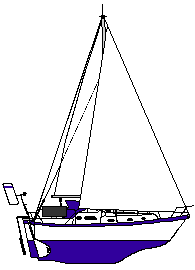 |
| Rusalka Mist under full mainsail and genoa. |
Plain sail on a Vancouver 28 is the high-cut yankee, the stay-sail and the main. This serves well in winds up to Force 4 or 5. If we get well up into Force 5, something has to go and it can be either the yankee, which rolls away quickly on the roller-reefing, or we can leave that out and put a first reef in the main. Reefing the main is more hassle but Rusalka Mist is better balanced on the wind if we do this early. "You should always put in a reef when you first think of it, and never shake it out again until you've had a cup of tea." This is good advice I've heard somewhere.
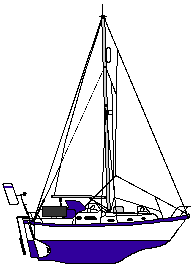 |
| Rusalka Mist under plain sail. |
When I bought her Rusalka Mist had been converted to single line reefing on the mainsail. The Kemp system of two pairs of travelling blocks inside the boom had been fitted. I could not get on with this as I don't think the cross-section of the boom was wide enough to allow the pairs of blocks to pass each other inside. They always seemed to jam during operations and made for slow, hard work. The length of the boom did not allow for the height of the second reef on the sail either, so the previous owner had had a new '1½' reef put in between the first and second. The deepest reef has only available after some re-wiring of the system. This was all a nuisance I could do without.
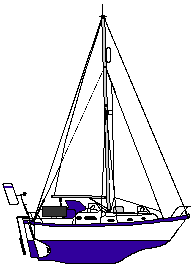 |
| Rusalka Mist under full mainsail and staysail. |
I took the advice of Bernard Amy, the local sailmaker, and converted to a simpler single line system with no blocks in the boom. We removed the '1½' reef point and operated each of the original two with long, circuitous reefing lines. These eventually pull down both the leech and luff of the sail, but not until a mile-and-a-half of line has been laboriously winched through. This worked well for a couple of years but became almost unworkable as the line became stiffer with age and weathering. I have recently converted her back to the original slab reefing system with hooks or horns on the gooseneck. It does require both of us on deck, but it is so simple and reliable. I would recommend this every time now.
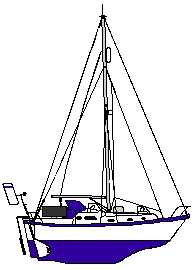 |
| Rusalka Mist under first reef and staysail. |
We have a storm jib, made of heavy sailcloth, high cut to resemble the yankee. It flies from the inner forestay, in place of the conventional staysail. With one reef in the main, the jib rolled and this up we are quite happy in Force 6 to 7. Beyond this we need the second reef in the main.
Rusalka sails quite happily through a range of wind angles on just the staysail. I have no storm trysail to replace the main as I cannot imagine unhanking the main and putting this up in the conditions in which it would be needed. A second sailtrack up the mast is not really feasible with all the other clutter already in place. I imagine that the storm staysail without jib or main would give us steerage across or down the wind in every gale until we needed no sail and would be reduced to running under bare poles.
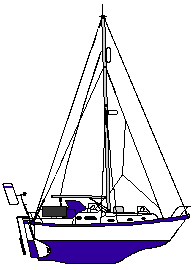 |
| Rusalka Mist under first reef and storm staysail. |
It is true that clawing off a lee shore in anything over Force 8 will not be possible. Our auxiliary diesel is not much use into a wind like that either, so we will have to avoid that possibility of rely on our heavy anchors at the last minute. You can't have everything on a small boat, unfortunately. Ultimately we may be reduced to scrambling up the rocks in heavy surf as we loose the boat, but this is very remote.
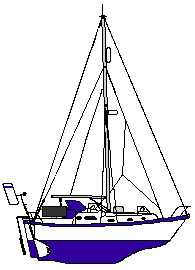 |
| Rusalka Mist under second reef and storm staysail. |
In deeper water, with plenty of lee-room, I imagine we shall be running under bare poles in Force 9, 10 or above. The problem then is to avoid being slung beam-on by breaking wave-tops. This is where the drogue comes in. Robin Knox-Johnstone in his description of his round-the-world trip, 'A World of my Own', and elsewhere, swears by towed warps in these conditions. He used "100 fathoms of 2-inch polypropylene rope". Translating this into modern units and allowing for the way he would measure rope by its circumference, not its diameter as we do, we can say 180 metres of 16 mm line.
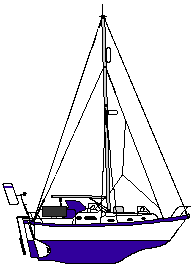 |
| Rusalka Mist under storm staysail only. |
I have about 100 m of 16 mm nylon anchorplait stored in two lengths in the fore-peak. The two 60-m anchor rodes stored in aft, side-deck lockers (see our Anchoring page for details) can be let out in deep water. One is chain and the other is 10 m of chain made up with 14 mm anchorplait. In case all this is not suitable or is not enough to hold her firmly stern-to-wind, we also carry a 48-inch Para-Tech® Delta Drogue. This needs a swivel and can be streamed from any combination of the above lines or warps. I think the best will be the mixed chain/anchorplait combination as the weight of the chain should hold it just far enough under the waves. We may never need to test this but it's good to know it's there.
The big problem with having taut lines over the stern in chafe. This applies when you are towing another vessel, towing warps or a drogue, when you are anchored by the stern Mediterranian-style, moored to a pontoon or a quay, or between buoys or piles. I have fitted two excellent stern rollers on the quarters. I found these in the American West Marine Catalogue. The rollers take most of the chafe away because they move with the line. In storm conditions extra rags or plastic tubes are still a good idea around the ropes as nothing is perfect. The alternative is regularly to 'freshen the nip' by letting out or hauling in a foot or two of rope before any part chafes seriously.
West Marine have an excellent catalogue and very good mail order service. They supplied our solar panels, voltage regulator, television swivel-mount and many other important bits and pieces.